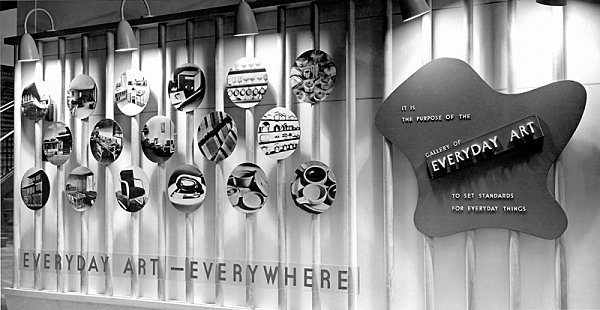
"For Modern Living" exhibition, designed and curated by Alexander Girard at the Detroir Institute of Arts, 1949
One of the earliest design shows at the Museum of Modern Art was called “Useful Object Under $5.” There’s not a lot of anxiety, or pretension, in that title. The exhibit opened at the museum in 1938 and then traveled to ten cities. The press release states that the wares include an aluminum tea kettle, a red rubber-covered dish drainer, a traveling iron, stainless steel knives, a shower curtain, a fur hangar. And that several items came from the five and dime.
The criteria for inclusion were described as follows:
(a) Uniformity: mechanically perfect finishYou could consider this a first draft for the museum at defining the tenets of "good design." The points overlap and repeat each other, and though they mention "utilitarian" they avoid price. The intersection of industrial production, new materials and new forms is still happening offstage; later exhibits, like Eliot Noyes's "Organic Design in Home Furnishings" would attempt to rope these players into the museum's discussion. The idea in the 1930s and 1940s was to try to improve popular taste ... by making it more modern.
(b) Precision: accuracy of form
(c) New forms
(d) New materials
(e) Absence of applied ornament: little ornament of true machine character has been developed; relianc is placed rather on perfection of form an inherent beauty of materials, often newly reveals by the machine.
(f) Economy of means: the designer's esthetic problem is to create something handsome out of utilitarian forms.
 "Ideas for Better Living" installation, Everyday Art Gallery, 1946 (Walker Art Center Archives)
"Ideas for Better Living" installation, Everyday Art Gallery, 1946 (Walker Art Center Archives)I've long been intrigued by these early intersections of commerce and curation. Last week at the Museum of Arts and Design I hosted the first of three panels on the topic, featuring presentations by Andrew Blauvelt on the Everyday Art Gallery at the Walker Art Center, Will Myers on MoMA, "Useful Objects" and "Good Design," and Monica Obniski on Alexander Girard's pioneering "For Modern Living" exhibition at the Detroit Institute of Arts. In the mid-20th century this particular anxiety did not exist. Curators were happy to point out where, and for how much, you could buy the items in their galleries. The hope was to change public taste, and to reward manufacturers doing it right. What was the impetus behind such shows? Who paid for them, and who went to them? And when did the idea of putting a price tag on a museum label become anathema? In each case, alliances between cultural institutions, manufacturers and sellers of objects were made transparently, with the common goal of facilitating access to the products that met the curators standards.

The Store at the Museum of Arts and Design (Laslo Regos Photography)
In recent years, it has become a slam to say, of design collections and exhibitions, that they looked like a shop. Design objects can be among the few items exhibited in museums that you could actually buy: When I take my son to the MoMA design collection, he looks in their glass fronted cases and sees the same Massimo Vignelli for Heller plates we have in our glass fronted cabinets at home. We can buy them downstairs in the store. How is he to understand them differently in each context? Should the differences be obvious? Or is the ability to experience design as a consumer how we spark an interest in history?
Tonight, I am turning that question around, inviting three retailers to come out from the store and into the galleries. Panelists include Ruth Shapiro, Director of Business Development, Museum of Modern Art; Franci Sagar, Director and Vice President of Retail and Brand Development, Museum of Arts and Design; and Stuart Gerstein, Director of Wholesale and Retail Operations, Philadelphia Museum of Art. What's the relationship of the store to the galleries behind the scenes and in the public's perception?

Past & Present: Vera Neumann, Design*Sponge (Illustration by Julia Rothman)
Next week, the final panel will remove us from bricks-and-mortar galleries and shops and take the discussion online. Where do we encounter design now? How do we buy it, and where can we learn about it? I will be joined by Amy Azzarito from Design*Sponge, Alison Feldmann from Etsy and Bradford Shellhammer from Fab. I hope that some New York-based readers will join me tonight or next Tuesday. Those who can't, I'm happy to take suggestions for questions for the panelists in the comments.
